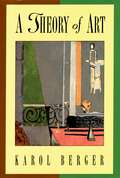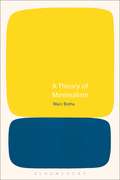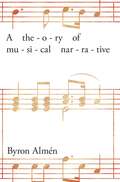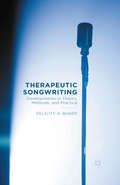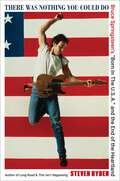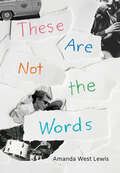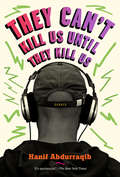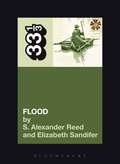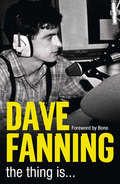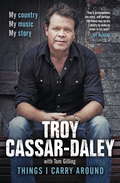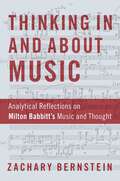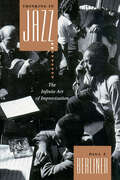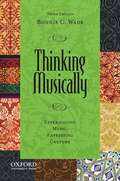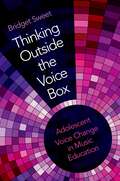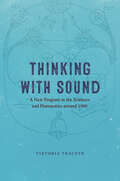- Table View
- List View
A Theory of Art
by Karol BergerWhat, if anything, has art to do with the rest of our lives, and in particular with those ethical and political issues that matter to us most? Will art created today be likely to play a role in our lives as profound as that of the best art of the past? A Theory of Art shifts the focus of aesthetics from the traditional debate of "what is art?" to the engaging question of "what is art for?" Skillfully describing the social and historical situation of art today, author Karol Berger argues that music exemplifies the current condition of art in a radical, acute, and revealing fashion. He also uniquely combines aesthetics with poetics and hermeneutics. Offering a careful synthesis of a wide breadth of scholarship from art history, musicology, literary studies, political philosophy, ethics, and metaphysics, and written in a clear, accessible style, this book will appeal to anyone with a serious interest in the arts.
A Theory of Minimalism
by Marc BothaThe explosion of minimalism into the worlds of visual arts, music and literature in the mid-to-late twentieth century presents one of the most radical and decisive revolutions in aesthetic history. Detested by some, embraced by others, minimalism's influence was immediate, pervasive and lasting, significantly changing the way we hear music, see art and read literature. In The Theory of Minimalism, Marc Botha offers the first general theory of minimalism, equally applicable to literature, the visual arts and music. He argues that minimalism establishes an aesthetic paradigm for rethinking realism in genuinely radical terms. In dialogue with thinkers from both the analytic and continental traditions – including Kant, Danto, Agamben, Badiou and Meillassoux – Botha develops a constellation of concepts which together encapsulate the transhistorcial and transdisciplinary reach of minimalism. Illustrated by a range of historical, canonical and contemporary minimalist works of different media, from the caves of early Christian ascetics to Samuel Beckett's late prose, Botha offers a bold and provocative argument which will equip readers with the tools to engage critically with past, present and future minimalism, and to recognize how, in a culture caught between the poles of excess and austerity, minimalism still matters.
A Theory of Minimalism
by Marc BothaThe explosion of minimalism into the worlds of visual arts, music and literature in the mid-to-late twentieth century presents one of the most radical and decisive revolutions in aesthetic history. Detested by some, embraced by others, minimalism's influence was immediate, pervasive and lasting, significantly changing the way we hear music, see art and read literature. In The Theory of Minimalism, Marc Botha offers the first general theory of minimalism, equally applicable to literature, the visual arts and music. He argues that minimalism establishes an aesthetic paradigm for rethinking realism in genuinely radical terms. In dialogue with thinkers from both the analytic and continental traditions – including Kant, Danto, Agamben, Badiou and Meillassoux – Botha develops a constellation of concepts which together encapsulate the transhistorcial and transdisciplinary reach of minimalism. Illustrated by a range of historical, canonical and contemporary minimalist works of different media, from the caves of early Christian ascetics to Samuel Beckett's late prose, Botha offers a bold and provocative argument which will equip readers with the tools to engage critically with past, present and future minimalism, and to recognize how, in a culture caught between the poles of excess and austerity, minimalism still matters.
Theory of Music Workbook Grade 1 (PDF)
by Naomi YandellTheory of Music Workbook Grade 1 for Trinity College London written exams.
Therapeutic Songwriting: Developments in Theory, Methods, and Practice
by F. BakerTherapeutic Songwriting provides a comprehensive examination of contemporary methods and models of songwriting as used for therapeutic purposes. It describes the environmental, sociocultural, individual, and group factors shaping practice, and how songwriting is understood and practiced within different psychological and wellbeing orientations.
There Was Nothing You Could Do: Bruce Springsteen's “Born In The U.S.A.” and the End of the Heartland
by Steven HydenA thought-provoking exploration of Bruce Springsteen&’s iconic album, Born in the U.S.A.—a record that both chronicled and foreshadowed the changing tides of modern America On June 4, 1984, Columbia Records issued what would become one of the best-selling and most impactful rock albums of all time. An instant classic, Bruce Springsteen&’s Born in the U.S.A. would prove itself to be a landmark not only for the man who made it, but rock music in general and even the larger American culture over the next 40 years. In There Was Nothing You Could Do, veteran rock critic Steven Hyden shows exactly how this record became such a pivotal part of the American tapestry. Alternating between insightful criticism, meticulous journalism, and personal anecdotes, Hyden delves into the songs that made—and didn&’t make—the final cut, including the tracks that wound up on its sister album, 1982&’s Nebraska. He also investigates the myriad reasons why Springsteen ran from and then embraced the success of his most popular (and most misunderstood) LP, as he carefully toed the line between balancing his commercial ambitions and being co-opted by the machine. But the book doesn&’t stop there. Beyond Springsteen&’s own career, Hyden explores the role the album played in a greater historical context, documenting not just where the country was in the tumultuous aftermath of Vietnam and Watergate, but offering a dream of what it might become—and a perceptive forecast of what it turned into decades later. As Springsteen himself reluctantly conceded, many of the working-class middle American progressives Springsteen wrote about in 1984 had turned into resentful and scorned Trump voters by the 2010s. And though it wasn&’t the future he dreamed of, the cautionary warnings tucked within Springsteen&’s heartfelt lyrics prove that the chaotic turmoil of our current moment has been a long time coming. How did we lose Springsteen&’s heartland? And what can listening to this prescient album teach us about the decline of our country? In There Was Nothing You Could Do, Hyden takes readers on a journey to find out.
These Are Not the Words
by Amanda West LewisNew York City in the 1960s is the humming backdrop for this poignant, gritty story about a girl who sees her parents as flawed human beings for the first time, and finds the courage to make a fresh start. Missy’s mother has gone back to school to pursue her dream of becoming an artist. Missy’s father works in advertising and takes Missy on secret midnight excursions to Harlem and the Village so she can share his love of jazz. The two write poems for each other — poems that gradually become an exchange of apologies as Missy’s father’s alcohol and drug addiction begins to take over their lives. When Missy’s mother finally decides that she and her daughter must make a fresh start, Missy has to leave her old apartment, her school, her best friend and her cats and become a latchkey kid while her mother gets a job. But she won’t give up on trying to save her family, even though this will involve a hard journey from innocence to action, and finally acceptance. Based on the events and people of her own childhood, Amanda Lewis’s gorgeous novel is driven by Missy’s irresistible, optimistic voice, buoyed by the undercurrents of poetry and music. Key Text Features poems dialogue literary references epigraph vignettes
They Can't Kill Us Until They Kill Us: Essays
by Hanif AbdurraqibA stunning collection of essays using music as a vantage point through which to examine and interrogate the world we live in, culturally and politically.In an age of confusion, fear, and loss, Hanif Abdurraqib’s is a voice that matters. Whether he’s attending a Bruce Springsteen concert the day after visiting Michael Brown’s grave, or discussing public displays of affection at a Carly Rae Jepsen show, he writes with a poignancy and magnetism that resonates profoundly.In the wake of the nightclub attacks in Paris, he recalls how he sought refuge as a teenager in music, at shows, and wonders whether the next generation of young Muslims will not be afforded that opportunity now. While discussing the everyday threat to the lives of black Americans, Abdurraqib recounts the first time he was ordered to the ground by police officers: for attempting to enter his own car.In essays that have been published by the New York Times, MTV, and Pitchfork, among others—along with original, previously unreleased essays—Abdurraqib uses music and culture as a lens through which to view our world, so that we might better understand ourselves, and in so doing proves himself a bellwether for our times.
They Might Be Giants' Flood (33 1/3)
by S. Alexander Reed Philip SandiferFor a few decades now, They Might Be Giants' album Flood has been a beacon (or at least a nightlight) for people who might rather read than rock out, who care more about science fiction than Slayer, who are more often called clever than cool. Neither the band's hip origins in the Lower East Side scene nor Flood's platinum certification can cover up the record's singular importance at the geek fringes of culture. Flood's significance to this audience helps us understand a certain way of being: it shows that geek identity doesn't depend on references to Hobbits or Spock ears, but can instead be a set of creative and interpretive practices marked by playful excess-a flood of ideas. The album also clarifies an historical moment. The brainy sort of kids who listened to They Might Be Giants saw their own cultural options grow explosively during the late 1980s and early 1990s amid the early tech boom and America's advancing leftist social tides. Whether or not it was the band's intention, Flood's jubilant proclamation of an identity unconcerned with coolness found an ideal audience at an ideal turning point. This book tells the story.
They Might Be Giants' Flood (33 1/3)
by S. Alexander Reed Philip SandiferFor a few decades now, They Might Be Giants' album Flood has been a beacon (or at least a nightlight) for people who might rather read than rock out, who care more about science fiction than Slayer, who are more often called clever than cool. Neither the band's hip origins in the Lower East Side scene nor Flood's platinum certification can cover up the record's singular importance at the geek fringes of culture. Flood's significance to this audience helps us understand a certain way of being: it shows that geek identity doesn't depend on references to Hobbits or Spock ears, but can instead be a set of creative and interpretive practices marked by playful excess-a flood of ideas. The album also clarifies an historical moment. The brainy sort of kids who listened to They Might Be Giants saw their own cultural options grow explosively during the late 1980s and early 1990s amid the early tech boom and America's advancing leftist social tides. Whether or not it was the band's intention, Flood's jubilant proclamation of an identity unconcerned with coolness found an ideal audience at an ideal turning point. This book tells the story.
The Thing is…
by Dave FanningDescribed as the Irish John Peel, Dave Fanning has been a major player in the Irish and global music scene for over 30 years.
Things I Carry Around: The bestselling memoir from the ARIA Award-winning country music star
by Tom Gilling Troy Cassar-DaleyA born storyteller, Troy Cassar-Daley has at last turned his talent to sharing his own inspiring life.‘Troy’s achievements are many, and perhaps the finest may be his ability to make us listen to his heart.’ Joy McKeanFor the first time, Troy talks about his early life - how his parent’s divorce changed things for him, about missing his Dad and growing up in Grafton surrounded by the warmth and love of his mother, Irene, his Nan and Pop and his extended Indigenous family. A larrikin at heart, Troy includes all the highs and lows on his path to stardom: the thrill of performing on stage at the Tamworth Music Festival with Jimmy Little when he was just 15; the excitement of heading off on tour with Brian Young and then discovering just how lonely life on the road could be; his first record deal; playing with the greats – Johnny Cash, Willie Nelson, Merle Haggard and Slim Dusty; his first album Beyond the Dancing, which blended his indigenous heritage with his rural background; meeting the woman who would steal his heart; recording in Nashville; and, finally, releasing True Believer, the album that really launched his career. The multiple Golden Guitar, APRA, ARIA and Deadlys winner also lets us in on some of the life lessons he learned the hard way, lessons that kept this prodigiously talented Aussie on the straight and narrow (most of the time). Things I Carry Around, is the warm, genuine, and inspiring story of a young indigenous Australian who had a dream and turned that dream into reality. ‘Troy’s a true gentleman, warm and genuine, always a pleasure to be around. He sings straight from his heart and straight from the heart of his country.’ Paul Kelly
Thinking In and About Music: Analytical Reflections on Milton Babbitt's Music and Thought
by Zachary BernsteinMilton Babbitt (1916-2011) was, at once, one of the century's foremost composers and a founder of American music theory. These two aspects of his creative life--"thinking in" and "thinking about" music, as he would put it--nourished each other. Theory and analysis inspired fresh compositional ideas, and compositional concerns focused theoretical and analytical inquiry. Accordingly, this book undertakes an excavation of the sources of his theorizing as a guide to analysis of his music. In Thinking In and About Music, author Zachary Bernstein shows how Babbitt's idiosyncratic synthesis of ideas from Heinrich Schenker, analytic philosophy, and cognitive science--at least as much as more obviously relevant predecessors such as Arnold Schoenberg--provide insight into his aesthetics and compositional technique. At the same time, a close look at his music reveals a host of concerns unaccounted for in his theories, some of which seem to directly contradict theoretical expectations. Bernstein argues, therefore, that new analytical models are needed to complement those suggested by Babbitt's theories. Departing from the serial logic of most previous work on the subject--and in an attempt to discuss Babbitt's music as it is actually heard rather than just deciphered--the book brings to bear theories of gesture and embodiment, rhetoric, text setting, and temporality. The result is a richly multi-faceted look at one of the twentieth century's most fascinating musical minds.
Thinking In and About Music: Analytical Reflections on Milton Babbitt's Music and Thought
by Zachary BernsteinMilton Babbitt (1916-2011) was, at once, one of the century's foremost composers and a founder of American music theory. These two aspects of his creative life--"thinking in" and "thinking about" music, as he would put it--nourished each other. Theory and analysis inspired fresh compositional ideas, and compositional concerns focused theoretical and analytical inquiry. Accordingly, this book undertakes an excavation of the sources of his theorizing as a guide to analysis of his music. In Thinking In and About Music, author Zachary Bernstein shows how Babbitt's idiosyncratic synthesis of ideas from Heinrich Schenker, analytic philosophy, and cognitive science--at least as much as more obviously relevant predecessors such as Arnold Schoenberg--provide insight into his aesthetics and compositional technique. At the same time, a close look at his music reveals a host of concerns unaccounted for in his theories, some of which seem to directly contradict theoretical expectations. Bernstein argues, therefore, that new analytical models are needed to complement those suggested by Babbitt's theories. Departing from the serial logic of most previous work on the subject--and in an attempt to discuss Babbitt's music as it is actually heard rather than just deciphered--the book brings to bear theories of gesture and embodiment, rhetoric, text setting, and temporality. The result is a richly multi-faceted look at one of the twentieth century's most fascinating musical minds.
Thinking in Jazz: The Infinite Art of Improvisation (Chicago Studies in Ethnomusicology)
by Paul F. BerlinerA landmark in jazz studies, Thinking in Jazz reveals as never before how musicians, both individually and collectively, learn to improvise. Chronicling leading musicians from their first encounters with jazz to the development of a unique improvisatory voice, Paul Berliner documents the lifetime of preparation that lies behind the skilled improviser's every idea. The product of more than fifteen years of immersion in the jazz world, Thinking in Jazz combines participant observation with detailed musicological analysis, the author's experience as a jazz trumpeter, interpretations of published material by scholars and performers, and, above all, original data from interviews with more than fifty professional musicians: bassists George Duvivier and Rufus Reid; drummers Max Roach, Ronald Shannon Jackson, and Akira Tana; guitarist Emily Remler; pianists Tommy Flanagan and Barry Harris; saxophonists Lou Donaldson, Lee Konitz, and James Moody; trombonist Curtis Fuller; trumpeters Doc Cheatham, Art Farmer, Wynton Marsalis, and Red Rodney; vocalists Carmen Lundy and Vea Williams; and others. Together, the interviews provide insight into the production of jazz by great artists like Betty Carter, Miles Davis, Dizzy Gillespie, Coleman Hawkins, and Charlie Parker. Thinking in Jazz overflows with musical examples from the 1920s to the present, including original transcriptions (keyed to commercial recordings) of collective improvisations by Miles Davis's and John Coltrane's groups. These transcriptions provide additional insight into the structure and creativity of jazz improvisation and represent a remarkable resource for jazz musicians as well as students and educators. Berliner explores the alternative ways—aural, visual, kinetic, verbal, emotional, theoretical, associative—in which these performers conceptualize their music and describes the delicate interplay of soloist and ensemble in collective improvisation. Berliner's skillful integration of data concerning musical development, the rigorous practice and thought artists devote to jazz outside of performance, and the complexities of composing in the moment leads to a new understanding of jazz improvisation as a language, an aesthetic, and a tradition. This unprecedented journey to the heart of the jazz tradition will fascinate and enlighten musicians, musicologists, and jazz fans alike.
Thinking in Jazz: The Infinite Art of Improvisation (Chicago Studies in Ethnomusicology)
by Paul F. BerlinerA landmark in jazz studies, Thinking in Jazz reveals as never before how musicians, both individually and collectively, learn to improvise. Chronicling leading musicians from their first encounters with jazz to the development of a unique improvisatory voice, Paul Berliner documents the lifetime of preparation that lies behind the skilled improviser's every idea. The product of more than fifteen years of immersion in the jazz world, Thinking in Jazz combines participant observation with detailed musicological analysis, the author's experience as a jazz trumpeter, interpretations of published material by scholars and performers, and, above all, original data from interviews with more than fifty professional musicians: bassists George Duvivier and Rufus Reid; drummers Max Roach, Ronald Shannon Jackson, and Akira Tana; guitarist Emily Remler; pianists Tommy Flanagan and Barry Harris; saxophonists Lou Donaldson, Lee Konitz, and James Moody; trombonist Curtis Fuller; trumpeters Doc Cheatham, Art Farmer, Wynton Marsalis, and Red Rodney; vocalists Carmen Lundy and Vea Williams; and others. Together, the interviews provide insight into the production of jazz by great artists like Betty Carter, Miles Davis, Dizzy Gillespie, Coleman Hawkins, and Charlie Parker. Thinking in Jazz overflows with musical examples from the 1920s to the present, including original transcriptions (keyed to commercial recordings) of collective improvisations by Miles Davis's and John Coltrane's groups. These transcriptions provide additional insight into the structure and creativity of jazz improvisation and represent a remarkable resource for jazz musicians as well as students and educators. Berliner explores the alternative ways—aural, visual, kinetic, verbal, emotional, theoretical, associative—in which these performers conceptualize their music and describes the delicate interplay of soloist and ensemble in collective improvisation. Berliner's skillful integration of data concerning musical development, the rigorous practice and thought artists devote to jazz outside of performance, and the complexities of composing in the moment leads to a new understanding of jazz improvisation as a language, an aesthetic, and a tradition. This unprecedented journey to the heart of the jazz tradition will fascinate and enlighten musicians, musicologists, and jazz fans alike.
Thinking in Jazz: The Infinite Art of Improvisation (Chicago Studies in Ethnomusicology)
by Paul F. BerlinerA landmark in jazz studies, Thinking in Jazz reveals as never before how musicians, both individually and collectively, learn to improvise. Chronicling leading musicians from their first encounters with jazz to the development of a unique improvisatory voice, Paul Berliner documents the lifetime of preparation that lies behind the skilled improviser's every idea. The product of more than fifteen years of immersion in the jazz world, Thinking in Jazz combines participant observation with detailed musicological analysis, the author's experience as a jazz trumpeter, interpretations of published material by scholars and performers, and, above all, original data from interviews with more than fifty professional musicians: bassists George Duvivier and Rufus Reid; drummers Max Roach, Ronald Shannon Jackson, and Akira Tana; guitarist Emily Remler; pianists Tommy Flanagan and Barry Harris; saxophonists Lou Donaldson, Lee Konitz, and James Moody; trombonist Curtis Fuller; trumpeters Doc Cheatham, Art Farmer, Wynton Marsalis, and Red Rodney; vocalists Carmen Lundy and Vea Williams; and others. Together, the interviews provide insight into the production of jazz by great artists like Betty Carter, Miles Davis, Dizzy Gillespie, Coleman Hawkins, and Charlie Parker. Thinking in Jazz overflows with musical examples from the 1920s to the present, including original transcriptions (keyed to commercial recordings) of collective improvisations by Miles Davis's and John Coltrane's groups. These transcriptions provide additional insight into the structure and creativity of jazz improvisation and represent a remarkable resource for jazz musicians as well as students and educators. Berliner explores the alternative ways—aural, visual, kinetic, verbal, emotional, theoretical, associative—in which these performers conceptualize their music and describes the delicate interplay of soloist and ensemble in collective improvisation. Berliner's skillful integration of data concerning musical development, the rigorous practice and thought artists devote to jazz outside of performance, and the complexities of composing in the moment leads to a new understanding of jazz improvisation as a language, an aesthetic, and a tradition. This unprecedented journey to the heart of the jazz tradition will fascinate and enlighten musicians, musicologists, and jazz fans alike.
Thinking in Jazz: The Infinite Art of Improvisation (Chicago Studies in Ethnomusicology)
by Paul F. BerlinerA landmark in jazz studies, Thinking in Jazz reveals as never before how musicians, both individually and collectively, learn to improvise. Chronicling leading musicians from their first encounters with jazz to the development of a unique improvisatory voice, Paul Berliner documents the lifetime of preparation that lies behind the skilled improviser's every idea. The product of more than fifteen years of immersion in the jazz world, Thinking in Jazz combines participant observation with detailed musicological analysis, the author's experience as a jazz trumpeter, interpretations of published material by scholars and performers, and, above all, original data from interviews with more than fifty professional musicians: bassists George Duvivier and Rufus Reid; drummers Max Roach, Ronald Shannon Jackson, and Akira Tana; guitarist Emily Remler; pianists Tommy Flanagan and Barry Harris; saxophonists Lou Donaldson, Lee Konitz, and James Moody; trombonist Curtis Fuller; trumpeters Doc Cheatham, Art Farmer, Wynton Marsalis, and Red Rodney; vocalists Carmen Lundy and Vea Williams; and others. Together, the interviews provide insight into the production of jazz by great artists like Betty Carter, Miles Davis, Dizzy Gillespie, Coleman Hawkins, and Charlie Parker. Thinking in Jazz overflows with musical examples from the 1920s to the present, including original transcriptions (keyed to commercial recordings) of collective improvisations by Miles Davis's and John Coltrane's groups. These transcriptions provide additional insight into the structure and creativity of jazz improvisation and represent a remarkable resource for jazz musicians as well as students and educators. Berliner explores the alternative ways—aural, visual, kinetic, verbal, emotional, theoretical, associative—in which these performers conceptualize their music and describes the delicate interplay of soloist and ensemble in collective improvisation. Berliner's skillful integration of data concerning musical development, the rigorous practice and thought artists devote to jazz outside of performance, and the complexities of composing in the moment leads to a new understanding of jazz improvisation as a language, an aesthetic, and a tradition. This unprecedented journey to the heart of the jazz tradition will fascinate and enlighten musicians, musicologists, and jazz fans alike.
Thinking Musically: Experiencing Music, Expressing Culture (pdf) (Global Music Ser.)
by Bonnie C. WadeAs the cornerstone of the Global Music Series, Thinking Musically, Third Edition, explores musical diversity by integrating the sounds and traditions of world cultures. Bonnie C. Wade discusses how various cultural influences-gender, ethnicity, mass media, westernization, nationalism, and acculturation-are shaping music and the ways that we experience it. WHAT'S NEW TO THE THIRD EDITION? * Simplified and incorporates recent additions to the Global Music Series * New charts and diagrams delve into important musical concepts * Updated companion website includes a new guide to online and print resources, a sample syllabi, and teaching tips Visit www.oup.com/us/globalmusic for a list of case studies in the Global Music Series. The website also includes instructional material to accompany each study.
Thinking Outside the Voice Box: Adolescent Voice Change in Music Education
by Bridget SweetThe changing adolescent voice counts among the most awkward of topics voice teachers and choir directors face. Adolescent voice students already find themselves at a volatile developmental time in their lives, and the stresses and possible embarrassments of unpredictable vocal capabilities make participation in voice-based music an especially fraught event. In this practical teaching guide, author Bridget Sweet encourages a holistic approach to female and male adolescent voice change. Sweet's approach takes full consideration of the body, brain, and auditory system; vocal anatomy and physiology in general, as well as during male and female voice change; and the impact of hormones on the adolescent voice, especially for female singers. Beyond the physical, it also addresses the emotional and psychological components: ideas of resolve and perseverance that are essential to adolescent navigation of voice change; and exploration of portrayals and stereotypes in pop culture that influence how people anticipate voice change experiences for teens and 'tweens, from The Brady Bunch to The Wonder Years to The Simpsons. As a whole, Teaching Outside the Voice Box encourages music educators to more effectively and compassionately assist students through this developmental experience.
Thinking Outside the Voice Box: Adolescent Voice Change in Music Education
by Bridget SweetThe changing adolescent voice counts among the most awkward of topics voice teachers and choir directors face. Adolescent voice students already find themselves at a volatile developmental time in their lives, and the stresses and possible embarrassments of unpredictable vocal capabilities make participation in voice-based music an especially fraught event. In this practical teaching guide, author Bridget Sweet encourages a holistic approach to female and male adolescent voice change. Sweet's approach takes full consideration of the body, brain, and auditory system; vocal anatomy and physiology in general, as well as during male and female voice change; and the impact of hormones on the adolescent voice, especially for female singers. Beyond the physical, it also addresses the emotional and psychological components: ideas of resolve and perseverance that are essential to adolescent navigation of voice change; and exploration of portrayals and stereotypes in pop culture that influence how people anticipate voice change experiences for teens and 'tweens, from The Brady Bunch to The Wonder Years to The Simpsons. As a whole, Teaching Outside the Voice Box encourages music educators to more effectively and compassionately assist students through this developmental experience.
Thinking with Sound: A New Program in the Sciences and Humanities around 1900
by Viktoria TkaczykThinking with Sound traces the formation of auditory knowledge in the sciences and humanities in the decades around 1900. When the outside world is silent, all sorts of sounds often come to mind: inner voices, snippets of past conversations, imaginary debates, beloved and unloved melodies. What should we make of such sonic companions? Thinking with Sound investigates a period when these and other newly perceived aural phenomena prompted a far-reaching debate. Through case studies from Paris, Vienna, and Berlin, Viktoria Tkaczyk shows that the identification of the auditory cortex in late nineteenth-century neuroanatomy affected numerous academic disciplines across the sciences and humanities. “Thinking with sound” allowed scholars and scientists to bridge the gaps between theoretical and practical knowledge, and between academia and the social, aesthetic, and industrial domains. As new recording technologies prompted new scientific questions, new auditory knowledge found application in industry and the broad aesthetic realm. Through these conjunctions, Thinking with Sound offers a deeper understanding of today’s second “acoustic turn” in science and scholarship.
Thinking with Sound: A New Program in the Sciences and Humanities around 1900
by Viktoria TkaczykThinking with Sound traces the formation of auditory knowledge in the sciences and humanities in the decades around 1900. When the outside world is silent, all sorts of sounds often come to mind: inner voices, snippets of past conversations, imaginary debates, beloved and unloved melodies. What should we make of such sonic companions? Thinking with Sound investigates a period when these and other newly perceived aural phenomena prompted a far-reaching debate. Through case studies from Paris, Vienna, and Berlin, Viktoria Tkaczyk shows that the identification of the auditory cortex in late nineteenth-century neuroanatomy affected numerous academic disciplines across the sciences and humanities. “Thinking with sound” allowed scholars and scientists to bridge the gaps between theoretical and practical knowledge, and between academia and the social, aesthetic, and industrial domains. As new recording technologies prompted new scientific questions, new auditory knowledge found application in industry and the broad aesthetic realm. Through these conjunctions, Thinking with Sound offers a deeper understanding of today’s second “acoustic turn” in science and scholarship.
